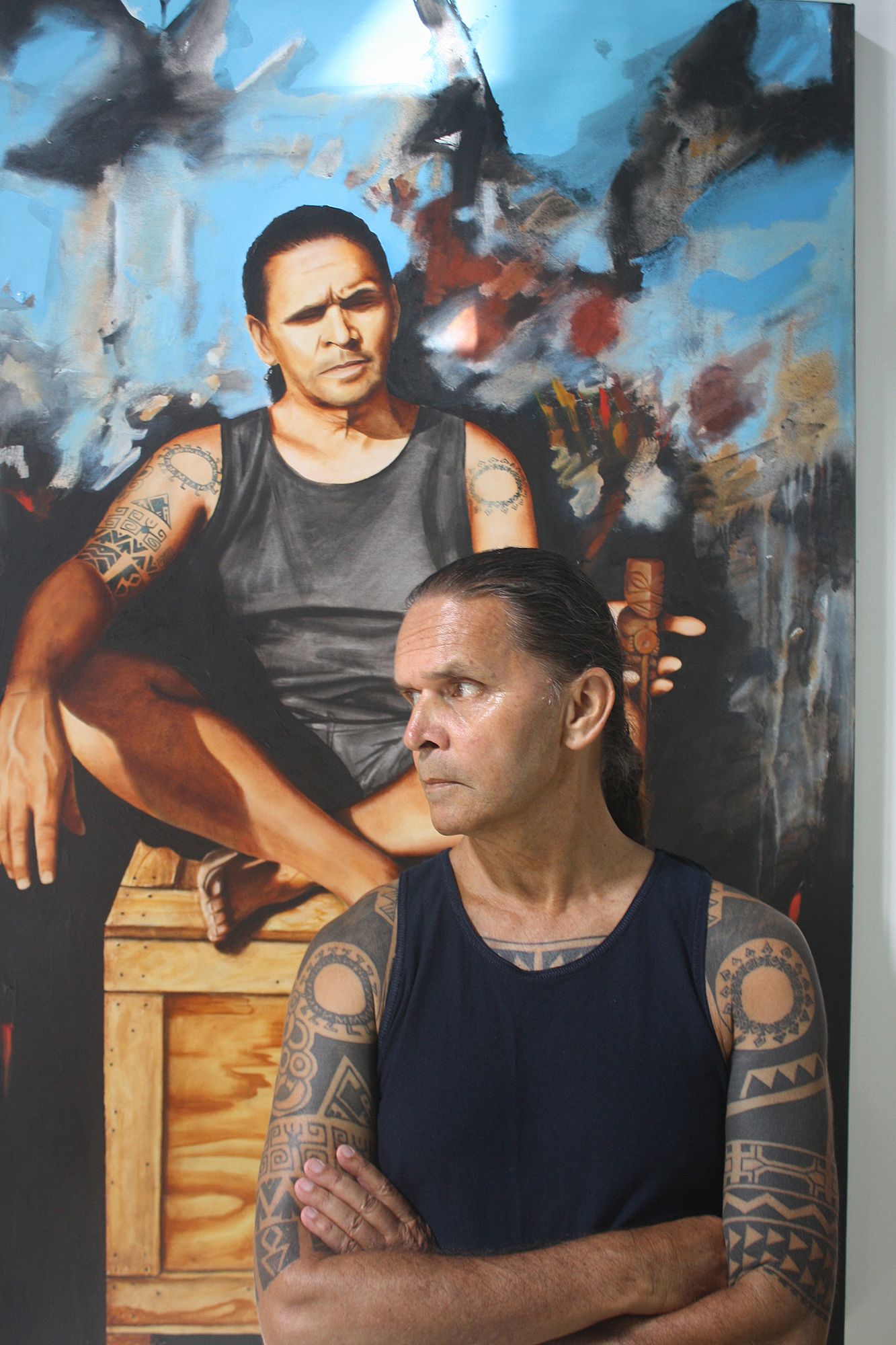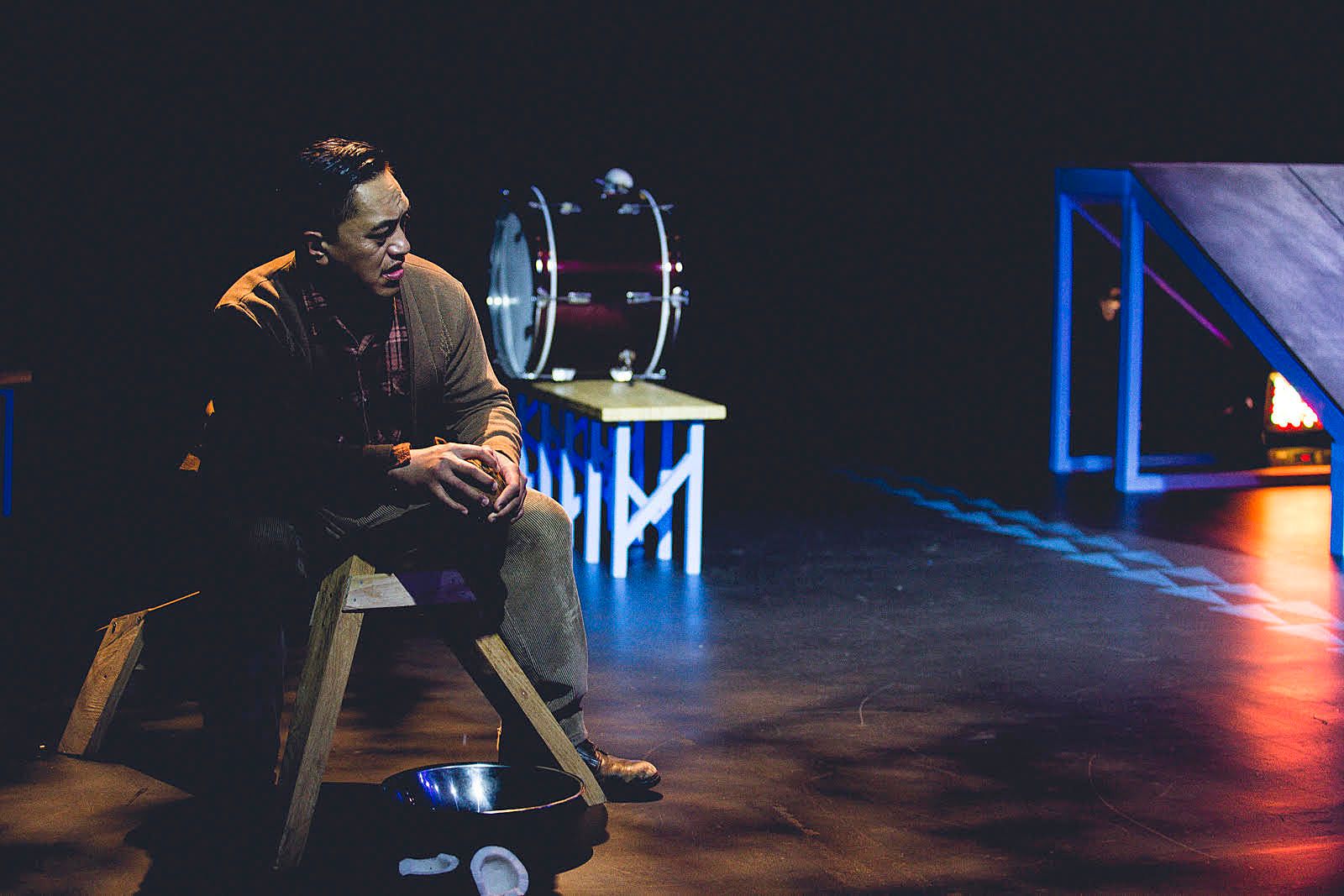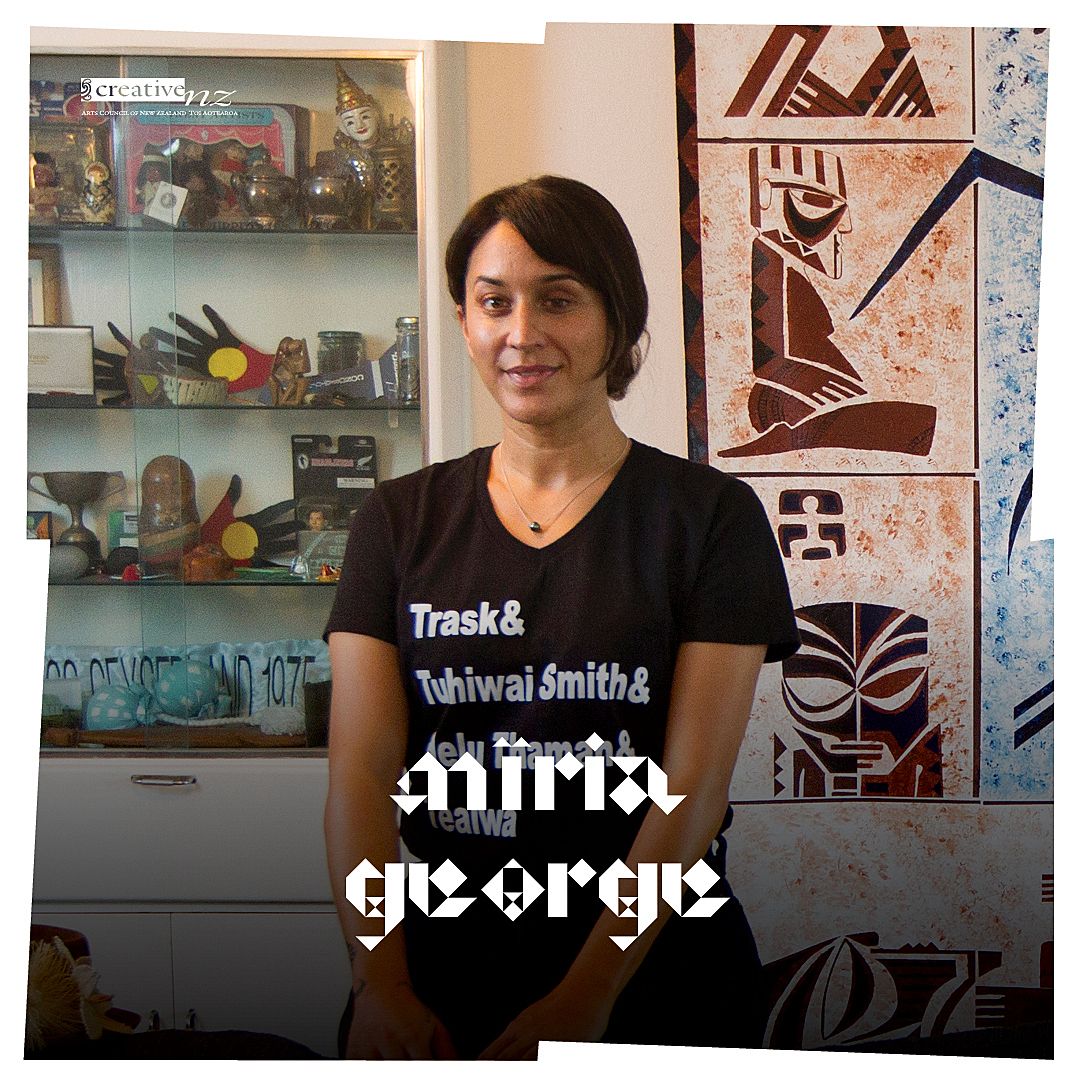We are all the movement forward
Playwright and co-founder of Tawata Productions Mīria George shares her creative journey as interconnected with other Kuki Aīrani artists finding their turangavaevae in Aotearoa.
We’re collaborating with Creative New Zealand to bring you the groundbreaking Pacific Arts Legacy Project. Curated by Lana Lopesi as project Editor-in-Chief, it’s a foundational history of Pacific arts in Aotearoa as told from the perspective of the artists who were there.
I was born in Aotearoa New Zealand in 1980, and my parents and grandparents took my older siblings and I home to the Cook Islands in 1983, first to vaka Puaikura, Akaoa, Rarotonga, and then to the village of Areora, on Atiu. This was years before my younger sister was born on our island of Rarotonga. For me, at three years old, this first journey would mark a lifetime of my father’s four children coming and going from our turangavaevae.
My father, Ian, himself a carver and painter, shared with me a lens through which to understand our islands – that of his own work and the work of others; of our artists. Carvers, painters, poets, short-story writers. Reflecting and questioning stories of then and now, they were asking, “Who have we become?” “Where do we go from here?” My siblings and I were raised with an abundance of these artists and their work in our lives. From our writers Papa Tom Davis, Alistair Teariki Campbell, Kauraka Kauraka, Jean Tekura Mason, Makiuti Tongia, Florence Syme Buchanan and Vaine Wichman, to our visual artists Papa Michael Tavioni, Awhitia Tavioni, Eruera Nia, Ani O’Neill and Sylvia Marsters. This way of seeing the world clung to me – through creativity the world would make more sense. It is through images that I still make sense of words. Pictures appear in my mind, and from there I devise the story. I have often wondered if this process could only be born to a child of a visual artist.
Ian George. Image by Kay George
Living in Aotearoa as an emerging artist in the early 2000s, I could look to our Māori theatre artists in Te Whanganui-a-Tara – Riwia Brown, Jim Moriarty, Apirana Taylor, Hone Kouka, Nancy Brunning, Briar Grace-Smith. Their whanaungatanga of emerging Māori artists was dynamic and active, their tautoko and awhinatanga extended to emerging Pasifika artists too. These great pou of Māori theatre threw open the doors for us – and they held it open, allowing as many of us to get through as possible. Their presence alone inspired us – the future could be limitless.
These great pou of Māori theatre threw open the doors for us – and they held it open, allowing as many of us to get through as possible
As a Cook Islands artist in New Zealand, Makerita Urale and Dianna Fuemana were two definitive beacons for me. Women of Pasifika heritage who began by writing, directing and producing for the stage, defiantly laying a pathway, for me – a writer, director and producer – and others to follow. Today, they are both still showing me the way. I’ve studied their migration from live performance into screen, and seen that it’s necessary to move so that my need to tell story can be sustained.
To me, writing for the stage is crafting images, memories and moments that are woven with characters and purpose. A question. An idea. With writing I can bend space and time. A want and a need. My first play was performed in Wellington in 2004. Oho Ake, directed by my partner Hone Kouka, designed by Jennifer Lal, Andy Foster and Stephen Gallagher, performed by Jamie McCaskill and Jason Te Kare. Oho Ake asked the question, the people or the land, can we ever be separated? For the next 13 years I wrote for the stage. I was fuelled by the immediacy of the art form. Playwriting dragged into the light the inequity and injustice of the world around me. Playwriting meant that the world could be righted by my own hands – and then crafted into theatre. and what remains, He Reo Aroha, Urban Hymns, Sunset Road, The Vultures and The Night Mechanics are the plays that followed on from my first.
It wasn’t lost on me at the time that the first invitation for a play of mine to tour was to the UK. Not Auckland, not Christchurch, not somewhere else a little more local. and what remains presented two seasons in the UK. He Reo Aroha (co-written with creative brother Jamie McCaskill) followed a similar path – and spent the first two years of its life touring Australia, Hawaiʻi and Canada. In 2020, the systemic imbalance across our arts sector continues to be perpetuated. We live here in Te Moana nui a kiva but our government is still gripping tightly to prioritising the resourcing of art forms that reflect our coloniser. For many artists in Aotearoa New Zealand, the investment needed to change long before Coronavirus came along.
We live here in Te Moana nui a kiva but our government is still gripping tightly to prioritising the resourcing of art forms that reflect our coloniser
There were few established Cook Islands theatre artists to look to when I emerged onto the scene. For me in Aotearoa, Glenda Tuaine, Karl Kite-Rangi, Rob Ringiao-Lloyd, Dominic Ona-Ariki and Taungaroa Emile were the ones that I was aware of at that time, actively training or working as independent artists and arts managers. For our people in Aotearoa, the Pasifika theatre space is not often dominated by iti tangata Kūki ‘Āirani. Not yet anyway. Our next generation of artists was born in Aotearoa and in the Cook Islands. They chased their hunger to tell stories. Te Hau Winitana, Braedyn Togi, Josh Baker, Ngariki Ngatae, Teherenui Koteka, Tyrone Elia, Roy Iro – they are on their way.
Sunset Road-12 Featuring Taungaroa Emile (Kūki 'Āirani Actor) Q Theatre, Auckland Image by Shovik Nandi
I cannot recall when I first met Taungaroa. It’s almost as if he has just always been a part of my life. In the 90s, like many others, my Ngatangiia creative brother was best known for many roles across iconic feature films from Aotearoa New Zealand. I would never have guessed that Taungaroa would become one of my longest-standing creative collaborators. Across nearly two decades of theatre and with me as I directed my first film. We both felt that familiar ache – for there to be more of our own people, for there to be more of our own stories claiming space in the landscape of contemporary theatre and film in Aotearoa.
Like many Kūki ‘Āirani artists before us, whether born in the islands, or born here in Aotearoa, the dream has always been to come and go from our turangavaevae with our own work. To share, engage and build capacity with our own villages, our own vaka. Like many others who have chosen to migrate, we are aware of the unique tension that can exist amongst our own people. For years, I read and re-read the poem ‘Darkness Within the Light’, in the book Return to Havaiki / Fokihanga ki Havaiki. In the mid 1980s, poet Kauraka Kauraka, of the island of Manihiki, took returning Cook Islanders to task – creatively. He spears the reader.
Think you’re smart?
Count, see who’s got the most?
You really think I’m dumb?
You’re not aware of the darkness within you light.
How I pity you!
Foreign knowledge has blinded your heart.1
I used to be gripped by the collision of worldviews, of ways of being – a collision common in many communities, in many families. Kauraka’s grief for a stronger connection with fellow Cook Islanders gripped at me, I despair, my friend, you leave me desolate!
Unfortunately, I know of the awkward space in which it seems, for some of our people, the fewer Kūki ‘Āirani artists, the better. I know of a vibe where the preferred context for some of our people is that if there is only one of us, then the progress of that individual will be guaranteed. That vibe is of no value. The more of us, the better. The more of us, the more lived experiences of our people will be shared. The more of us, the more a nuanced story of who we are is represented. My kōrero is only one of many others. In 2020, the doors are open and there is another generation of emerging artists of Cook Islands heritage on their way.
The more of us, the better. The more of us, the more lived experiences of our people will be shared
Taungaroa and I had always spoken about the want to create alongside our own people. When I was offered a writer–director role with the feature film Vai, I already knew that I wanted to include Taungaroa on screen – connecting our creative work directly to the island that we are both from. I’d worked with Taungaroa across numerous productions by Tawata – both producing and directing. I have always enjoyed the wrestle of our creative collaboration.
After the completion of the filming of Vai (Brown Sugar Apple Grunt Productions) in Rarotonga in 2018, my Uncle Tupu Araiti wrote me – e toto ki te toto, he said, blood-to-blood connections. A reminder of family and ‘akapapaanga. My Uncle Tupu was writing after my fearless cousin Evotia-Rose Araiti (who performed Vai in the film) and I had completed filming. My uncle also pointed out that there must be something in the water near the island of Enua Manu – or Atiu as it is more widely known – as my older brother Robert George, and our cousins Sharlene George and Catherine George, all work across the visual arts, film and live performance landscape. I imagine e toto ki te toto as an ongoing interconnectedness of not only our family, but also of our people.
As I write this, Evotia-Rose and I are in pre-production for the short film Fire in the Water, Fire in the Sky. The film is based on a live performance installation of the same name. Performed in gallery and museum spaces, the work is about Western imperialism and the ongoing untangling of colonisation in the Pacific. Evotia-Rose is joining an original collaborator of mine, my creative sister Te Hau Winitana, dancer and choreographer, whose heritage is also from the island of Atiu.
Director Mīria and lead actor Evotia-Rose Araiti on set of 'Vai', in the village of Aka'oa, Rarotonga. Image by Brown Sugar Apple Grunt
Pacific nations have navigated inequity since the original pandemic, imperialism, arrived on our shores as colonialism. The next generation of artists coming through, like those before them, want to push through this original pandemic and understand our islands’ knowledge systems before this time. We know our people's vision for the island of Rarotonga is greater than the return of flights and airlines and their ever-expanding services to the Cook Islands; greater than the ongoing hunger to progress the Avana foreshore development; or greater than the need to turn family homes into tourist accommodation. This is not the future we dream of.
Will we, the Pacific, remain the pleasure tool of others – where outsiders can come, eat, drink and be merry – all the while contributing to the dire exploitation of our land and water? I am reminded of the words of the poet Vaine Wichman.
We take pride in visitors’ comments that we have a paradise
And in so doing
we propagate the fallacy that it will always
be that way,
even if our toxic poisons seep from the land
to the sea, through our ocean of hope.2
I keep asking myself, when development across Rarotonga and other Pacific nations surges – who truly benefits? Where is our rangatiratanga?
Of course, change has already begun. Whether we are ready for it or not.
By 2017, Tawata Productions, a Māori and Cook Islands creative company led by myself and Hone Kouka, was 14 years old. In 2017, the collective Maranga Mai was born. A collective featuring women from throughout Wellington, Maranga Mai presents new work from writers refining their craft. Maranga Mai are mothers, community leaders, tertiary students and full-time workers, who at nights and on weekends are also committed writers. This year the collective features Sandra Tisam, Tina McNicholas, Natalia Fareti, Sherilee Kahui, Te Aorewa Rolleston, Teherenui Koteka and Stevie Greeks. Maranga Mai actively holds space for women who write. For many, this collective redefines the way collaboration can take place; for us, Maranga Mai operates much like a village – together, anything is possible. Yes, Maranga Mai creates opportunity, sharing more narratives from women our creative landscape in Aotearoa still does not hear enough from.
Although my return home to my turangavaevaehas been stalled, the interconnectedness of this generation of Kūki ‘Āirani artists continues to strengthen. We are all the movement forward.
1 Kauraka Kauraka, Return to Havaiki / Fokihanga ki Havaiki (Suva, Fiji: The Institute of Pacific Studies, USP, 1985).
2 Vaine (Rasmussen) Wichman, “A Legacy,” in Te-Ava Ora (Suva, Fiji: Mana Publications, 1999)
CNZ Logo
This piece is published in collaboration with Creative New Zealand as part of the Pacific Arts Legacy Project, an initiative under Creative New Zealand’s Pacific Arts Strategy. Lana Lopesi is Editor-in-Chief of the project.
Series design by Shaun Naufahu, Alt Group. Header photo supplied by Stuff Limited.





